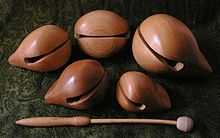Temple block


The temple block is a percussion instrument originating in China, Japan and Korea where it is used in religious ceremonies.
It is a carved hollow wooden instrument with a large slit. In its traditional form, the wooden fish, the shape is somewhat bulbous; modern instruments are also used which are rectangular in shape. Several blocks of varying sizes are often used together to give a variety of pitches. In Western music, their use can be traced back to early jazz drummers, and they are not uncommon in modern orchestral music, where they are also called dragons' mouths.
Its sound is similar to that of the wood block, although temple blocks have a darker, more "hollow" timbre.
It can be clearly heard in Leroy Anderson's The Syncopated Clock and is also used in Olivier Messiaen's only symphony, Turangalîla, and his only opera, Saint-François d'Assise. Harrison Birtwistle calls for 4 temple blocks in his 2008 opera The Minotaur, Magnus Lindberg calls for 5 in Seht die Sonne and Pierre Boulez for one in Notations I-IV. Leonard Bernstein, George Benjamin and David Horne also used it in their compositions. Rush's songs Xanadu from their 1977 album A Farewell To Kings and The Trees from their 1978 album Hemispheres also use temple blocks - the blocks that Neil Peart is striking in these tracks can be heard very clearly.
An updated version of traditional wooden temple blocks are so-called granite blocks, however not made of stone, but of waterproof plastic, and therefore often used instead of actual temple blocks e.g. by street orchestras, in that case usually mounted on a portable frame, either rolled on wheels or carried by the player on his or her shoulders while playing, as shown on the picture from the Carnival of Basel in 2013.
| ||||||||||||||||||||||||||||||